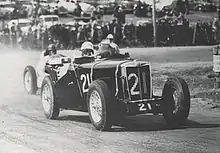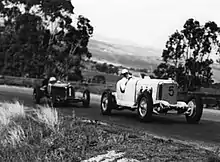1947 Australian Grand Prix
The 1947 Australian Grand Prix was a Formula Libre motor race held at the Mount Panorama Circuit, near Bathurst in New South Wales, Australia on 6 October 1947. The race, which had 22 starters, was held over 38 laps of the six kilometre circuit, for a total race distance of 241 kilometres.
| 1947 Australian Grand Prix | |||
|---|---|---|---|
| Formula Libre handicap race | |||
| Race details | |||
| Date | 6 October 1947 | ||
| Location | Mount Panorama Circuit, Bathurst, New South Wales | ||
| Course | Temporary road circuit | ||
| Course length | 6.12 km (3.84 mi) | ||
| Distance | 38 laps, 241.35 km (150 mi) | ||
| Weather | Sunny | ||
| Fastest lap | |||
| Driver |
| Alfa Romeo Monza [1] | |
| Time | 3 min 6 sec [1] | ||
| Podium | |||
| First | MG | ||
| Second | Mercury Special | ||
| Third | Mercedes-Benz | ||


It was the twelfth Australian Grand Prix and the first to have been held after the conclusion of World War II. Racing in Australia resumed in 1946, but it took until 1947 for a group, in this case the Australian Sporting Car Club, to take on the running of the Grand Prix. Police opposition to racing at Mount Panorama led to the postponement of the race from Easter to October.[2]
The race, a handicap event as was the tradition in the immediate post-war period, was won by Bill Murray racing his MG TC. Murray took the lead on the last lap of the race after a tyre failure on Ray Mitchell's Jeep/Ford Special caused the race leader to slow dramatically. Mitchell limped home for fourth position. Future Grand Prix stars also passed Mitchell, second was taken by Dick Bland in his Mercury Special. Bland would claim two more podiums over the four years but a win would be elusive. Third was taken by Lex Davison driving a 7.6 litre Mercedes-Benz SSK 38/250.[3] Davison would go on to become the Grand Prix's most prolific winner, even though his career would be cut short by his death at Sandown in 1965, Davison would win the race four times. Davison also completed the race in the shortest time, a prelude to the future of the race over the next decade and a half.
Alf Barrett (Alfa Romeo Monza) started the race from scratch, 37 minutes after the first starter, Les Burrows (MG J2).[2] Barrett retired on lap 29 with valve trouble, having earlier set the fastest lap of the race at 3 minutes 6 seconds.[1] He also achieved the fastest speed of 123.5 mph through the flying quarter-mile.[4]
The Under 1500cc Championship was awarded to Alf Najar and the Over 1500cc Championship to Lex Davison, both titles being decided on net race time,[4] disregarding handicaps.
The race was watched by 20,000 spectators.[5]
Classification
Results as follows.[6]
| Pos | No. [7] | Driver | Car / engine | Laps | Time | Handicap (minutes) |
|---|---|---|---|---|---|---|
| 1 | 21 | MG TC / MG 1.3L | 38 | 2h 39m 46s | 25.5 | |
| 2 | 7 | Mercury Special / Mercury 3.7L | 38 | 2h 40m 22s | 15.0 | |
| 3 | 5 | Mercedes-Benz SSK 38/250 / Mercedes-Benz 7.6L | 38 | 2h 40m 33s | 10.5 | |
| 4 | 11 | Jeep/Ford Special / Ford 3.6L | 38 | 2h 41m 09s | 17.0 | |
| 5 | 23 | Sulman Singer Special / Singer 1.0L | 38 | 2h 41m 48s | 28.0 | |
| 6 | 15 | MG TB Special / MG 1.3L | 38 | 2h 41m 37s | 19.5 | |
| 7 | 14 | Mercury Special / Mercury 3.9L | 38 | 2h 41m 59s | 17.0 | |
| 8 | 17 | MG NE Magnette [5] / MG 1.3L | 38 | 2h 42m 10s | 21.0 | |
| 9 | 13 | MG TA Special / MG 1.4L | 38 | 2h 43m 55s | 19.5 | |
| 10 | 28 [4] | MG J2 / MG 0.8L | 38 | 2h 44m 37s | 37.0 | |
| 11 | 19 | MG TB / MG 1.3L | 38 | 2h 45m 37s | 25.5 | |
| 12 | 27 | Riley Imp / Riley 1.1L | 38 | 2h 46m 01s | 34.0 | |
| 13 | 18 | MG TB / MG 1.3L | 38 | 2h 47m 55s | 25.5 | |
| 14 | 22 | MG TC / MG 1.3L | 38 | 2h 48m 28s | 25.5 | |
| Ret | 1 | Alfa Romeo Monza / Alfa Romeo 2.4L | 28 [1] | Scratch | ||
| Ret | 9 | Bugatti Type 39 / Ford 3.6L (DM Special) [7] | 28 | 15.0 | ||
| Ret | 2 | Kleinig-Hudson 8 Special / Hudson 4.2L | 26 | 6.0 | ||
| Ret | 20 | MG TB / MG 1.3L | 22 | 25.5 | ||
| Ret | 26 | Austin 7 / Austin 0.8L | 20 | 31.0 | ||
| Ret | 3 | Dixon / Riley 1.8L | 7.5 | |||
| Ret | 4 | Buick Special / Buick 3.8L | 10.5 | |||
| Ret | 16 | Jaguar SS100 / Standard 2.7L | 20.0 | |||
| DNS | 8 | Ford V8 Special / Ford 3.6L | 15.0 | |||
| DNS | 12 | Mercury Special / Mercury 3.9L | 17.0 | |||
| DNS | 29 | MG K3 / MG 1.3L | 15.0 | |||
| DNS | 24 | MG NE / MG 1.1L | 28.0 | |||
References
- John B Blanden, Historic Racing Cars in Australia, 1979, page 18
- Medley, John (1986). "1947". In Howard, Graham (ed.). The Official 50-race history of the Australian Grand Prix. Gordon, NSW: R & T Publishing. p. 116. ISBN 0-9588464-0-5.
- Stefan Bartholomaeus, Mercedes-Benz in Australian motorsport Retrieved from www.speedcafe.com on 20 September 2012
- Australian Grand Prix, Australian Motor Sports, 15 October 1947, pages 26-28
- Sydney Morning Herald (NSW : 1842–1954), Tuesday 7 October 1947, page 8 As retrieved from nla.gov.au on 15 May 2016
- Medley, John (1986). "1947". In Howard, Graham (ed.). The Official 50-race history of the Australian Grand Prix. Gordon, NSW: R & T Publishing. pp. 116–124. ISBN 0-9588464-0-5.
- Australian Grand Prix - Final Acceptances, Australian Motor Sports, 15 October 1947, page 5
| Preceded by 1939 Australian Grand Prix |
Australian Grand Prix 1947 |
Succeeded by 1948 Australian Grand Prix |